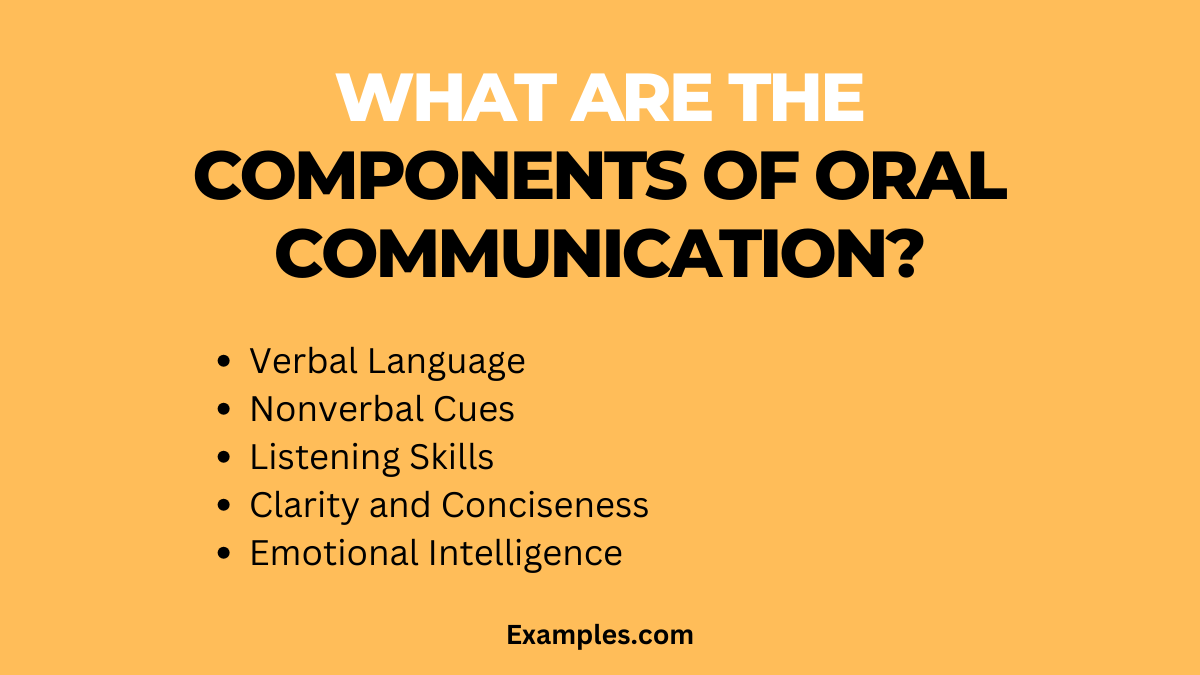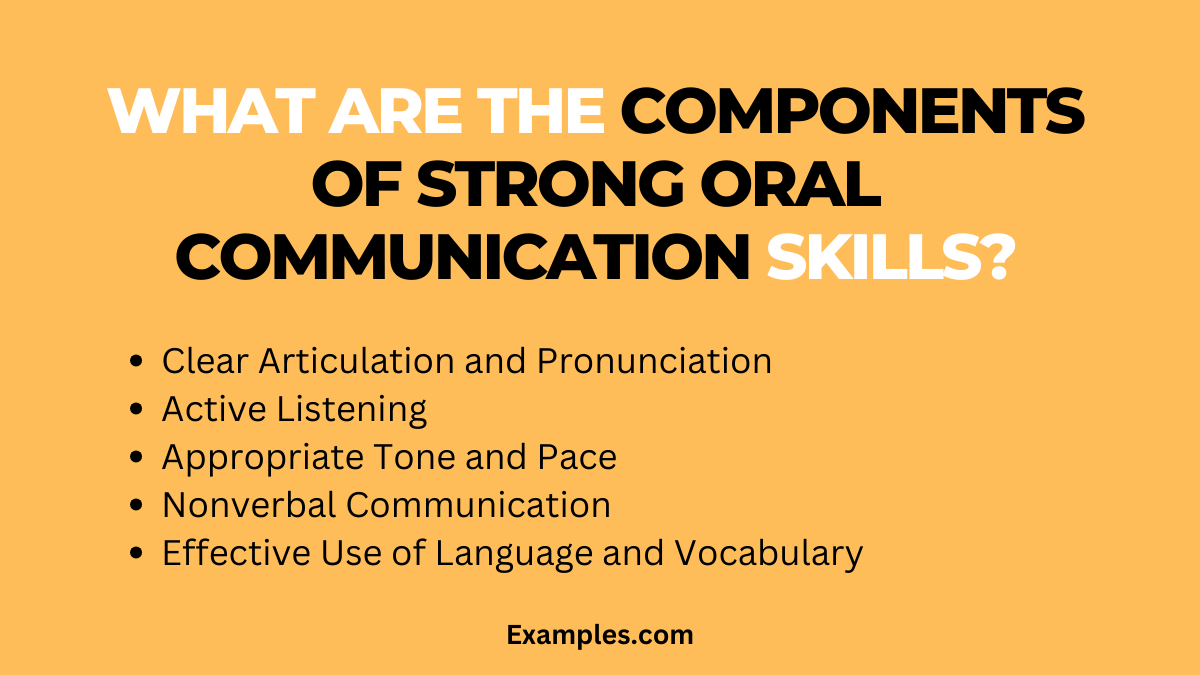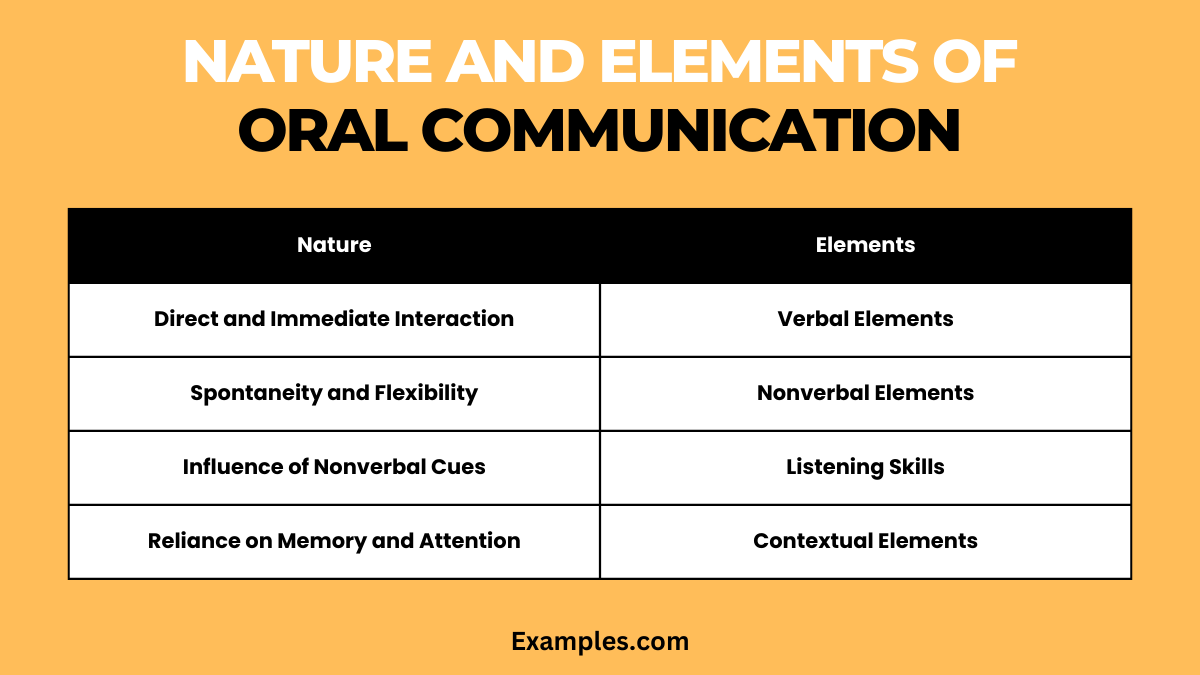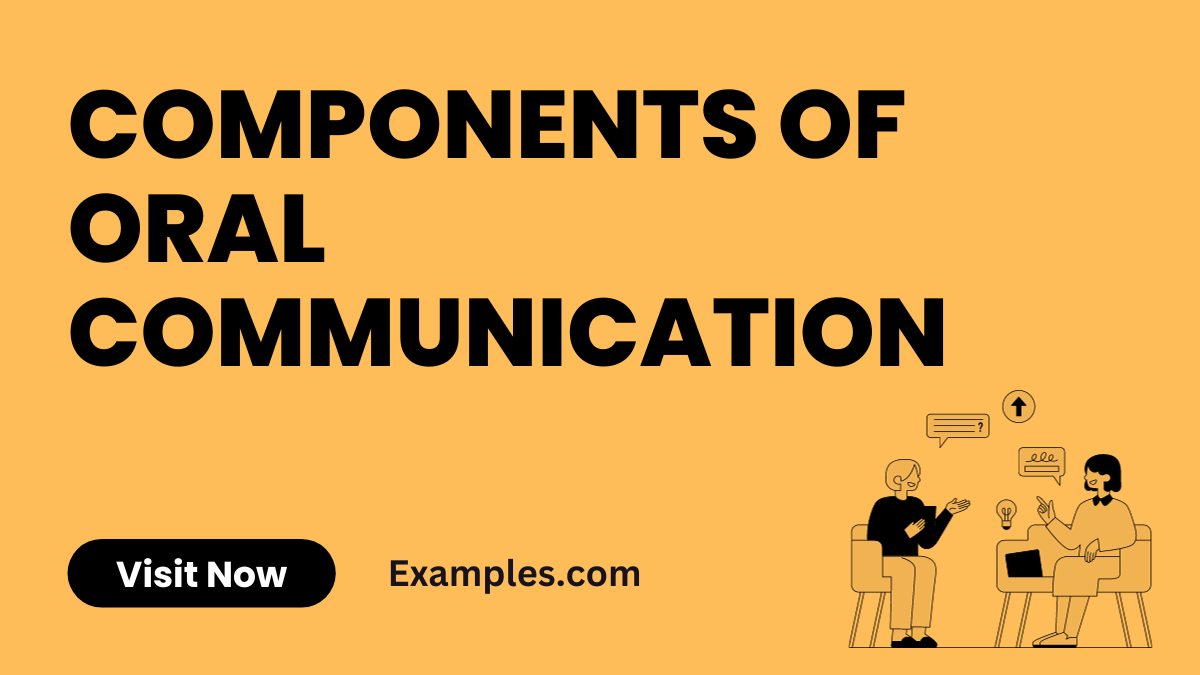10 Components of Oral Communication Examples
Oral communication is a vital skill, encompassing various components that contribute to effective dialogue. This guide delves into each element, providing communication examples to illustrate their practical application. From mastering the art of verbal expression to understanding the power of nonverbal cues, this resource offers insights into how each component plays a crucial role in conveying messages clearly and effectively. Ideal for anyone looking to enhance their oral communication skills, whether in personal conversations or professional settings.
What are the Components of Oral Communication?

Oral communication is a multifaceted process involving several key components. Understanding these elements is crucial for effective verbal interaction.
Verbal Language
- Word Choice: The selection of words greatly impacts the clarity and effectiveness of communication.
- Tone of Voice: The tone conveys emotions and attitudes, affecting how the message is received.
Nonverbal Cues
- Body Language: Nonverbal signals like gestures and posture communicate much about intent and feelings.
- Facial Expressions: These provide cues to emotions and reactions, often complementing or contradicting spoken words.
Listening Skills
- Active Listening: Engaging attentively with the speaker to fully comprehend their message.
- Feedback: Providing responses or asking questions based on what is heard to facilitate understanding.
Clarity and Conciseness
- Clear Articulation: Pronouncing words clearly and avoiding ambiguity.
- Brevity: Being concise yet comprehensive in conveying the message.
Emotional Intelligence
- Empathy: Understanding and sharing the feelings of others in conversation.
- Self-awareness: Being conscious of your own emotions and how they influence communication.
Understanding and effectively utilizing these components can significantly enhance oral communication, making interactions more impactful and meaningful.
What are the Basic Elements Needed for Effective Oral Communication?
Effective oral communication hinges on several foundational elements:
Clear and Precise Language
- Simple Language: Using straightforward language for ease of understanding.
- Precision: Being accurate in the expression of ideas or facts.
Active Engagement
- Interactivity: Encouraging a two-way communication process.
- Engagement: Showing interest and responding appropriately to maintain the flow of conversation.
Adaptability
- Flexibility: Adjusting the communication style according to the audience or situation.
- Cultural Sensitivity: Being aware of and respecting cultural differences in communication.
Confidence and Assertiveness
- Confidence: Speaking with assurance to convey credibility.
- Assertiveness: Expressing thoughts and opinions firmly yet respectfully.
Effective Use of Technology
- Digital Communication Tools: Leveraging technology like video calls for distant communication.
- Online Presentation Skills: Effectively communicating through digital mediums.
Mastering these basic elements lays the groundwork for effective and impactful oral communication in various social and professional contexts.
What are the Components of Strong Oral Communication Skills?

Strong oral communication skills are essential for effective interpersonal interactions. Understanding the key components can greatly enhance the quality of your conversations.
Clear Articulation and Pronunciation
- Essential for Understandability: Clear articulation ensures that your words are understood without misinterpretation.
- Importance in Professional Settings: Especially crucial in professional environments to convey messages effectively.
Active Listening
- Engaging in Conversations: Involves fully focusing on the speaker and understanding their message.
- Enhances Interaction Quality: Leads to more meaningful and productive interactions.
Appropriate Tone and Pace
- Reflects Emotion and Intent: The tone of voice conveys your feelings and the intent behind your words.
- Pace Control: Maintaining an appropriate speed of speech to ensure clarity and comprehension.
Nonverbal Communication
- Body Language and Gestures: These nonverbal cues supplement verbal communication, providing additional context.
- Facial Expressions: Convey emotions and reactions, aiding in the overall communication process.
Effective Use of Language and Vocabulary
- Choosing Words Wisely: Using language that is appropriate for your audience.
- Vocabulary Expansion: A broad vocabulary allows for more precise and varied expression.
How Components of Oral Communication are Used?
Oral communication is more than just speaking; it’s about effectively conveying a message. Here’s how these components are used:
In Personal Conversations
- Building Relationships: Effective oral communication helps in building and maintaining personal relationships.
- Expressing Personal Thoughts: Clearly expressing personal opinions and feelings.
In Professional Settings
- Workplace Communication: Essential for team discussions, presentations, and negotiations.
- Client Interactions: Used in client meetings and networking events for clear and persuasive communication.
In Public Speaking
- Engaging the Audience: Captivating the audience with clarity, tone, and body language.
- Delivering Speeches: Utilizing all components to deliver impactful and memorable speeches.
In Educational Contexts
- Teaching and Learning: Teachers and students use these skills for effective teaching and understanding.
- Group Discussions: Facilitating and participating in educational discussions and debates.
In Everyday Life
- Routine Interactions: Used in daily interactions with friends, family, and acquaintances.
- Social Events: Communicating effectively in various social settings and events.
By mastering these components, individuals can enhance their ability to communicate effectively in diverse situations, leading to improved relationships and professional success.
What are the Nature and Elements of Oral Communication?

Oral communication is an integral part of human interaction, encompassing a variety of elements that work together to ensure the effective exchange of ideas and information. Understanding the nature and elements of oral communication is crucial for both personal and professional interactions.
The Nature of Oral Communication
The nature of oral communication is multifaceted, encompassing various aspects that contribute to its effectiveness in conveying messages and emotions.
Direct and Immediate Interaction
- Real-Time Exchange: Oral communication allows for instant feedback and response, making interactions dynamic and immediate.
- Personal Touch: The face-to-face aspect adds a personal element, enhancing the connection between speakers.
Spontaneity and Flexibility
- Spontaneous Responses: Unlike written communication, oral exchanges often involve spontaneous reactions and replies.
- Adaptability: Speakers can quickly adjust their message or tone based on the listener’s reactions or the conversation’s direction.
Influence of Nonverbal Cues
- Body Language and Gestures: Nonverbal elements like facial expressions, gestures, and posture play a significant role in reinforcing or contradicting spoken words.
- Tone and Pitch: The tone, pitch, and pace of speech also impart additional meaning to the spoken words, influencing the listener’s perception.
Reliance on Memory and Attention
- Memory-Based: Oral communication often relies on the memory of both the speaker and the listener, unlike written communication where information can be revisited.
- Attention-Dependent: The effectiveness of oral communication is heavily dependent on the listener’s attention span and focus.
Cultural and Linguistic Influences
- Cultural Nuances: Different cultures have unique norms and practices in oral communication, affecting how messages are delivered and interpreted.
- Language Barriers: Language proficiency and accents can either facilitate or hinder effective oral communication.
Understanding these inherent characteristics of oral communication is crucial for anyone looking to improve their communication skills. Recognizing the nature of oral exchanges helps in tailoring messages appropriately and enhances interpersonal interactions in both personal and professional contexts.
Key Elements of Oral Communication
Verbal Elements:
- Words and Language: The choice of words and language structure plays a crucial role. It involves selecting appropriate terminology and phrasing that the audience can understand and relate to.
- Tone and Clarity: The tone conveys emotions and attitudes, while clarity ensures the message is understood as intended.
Nonverbal Elements:
- Body Language: Gestures, facial expressions, and posture complement verbal messages and can often convey more than words alone.
- Eye Contact: Maintaining eye contact establishes trust and engagement with the audience.
Listening Skills:
- Active Listening: Effective oral communication isn’t just about speaking; it’s equally about listening attentively to understand and respond appropriately.
- Feedback Interpretation: Interpreting and responding to verbal and nonverbal feedback from listeners is essential for interactive communication.
Contextual Elements:
- Cultural and Social Context: Being aware of the cultural and social nuances can influence how messages are conveyed and received.
- Setting and Environment: The physical setting and environment can impact the effectiveness of oral communication.
Emotional Intelligence:
- Empathy: Understanding and acknowledging the listener’s feelings can greatly enhance the communication process.
- Self-awareness: Being aware of one’s own emotions and how they affect communication is vital.
The nature of oral communication is characterized by its interactive, immediate, and adaptive qualities. Its elements span verbal and nonverbal aspects, listening skills, contextual understanding, and emotional intelligence, all of which are essential for effective communication. These components work together to create a cohesive and impactful communication experience.
How to Describe Oral Communication Skills?
Describing oral communication skills involves highlighting various aspects that contribute to effective spoken interactions. These skills are integral in conveying messages clearly, engaging listeners, and ensuring mutual understanding.
Clarity and Articulation
- Clear Expression: The ability to express thoughts and ideas clearly without ambiguity.
- Proper Articulation: Pronouncing words correctly and speaking at an understandable pace.
Listening and Understanding
- Active Listening: Paying close attention to the speaker, showing engagement, and understanding their message.
- Empathetic Responses: Responding in a way that shows comprehension and empathy towards the speaker’s viewpoint.
Nonverbal Communication
- Body Language: Using gestures, facial expressions, and posture to complement verbal messages.
- Eye Contact: Maintaining appropriate eye contact to engage with the audience and build trust.
Adaptability and Responsiveness
- Flexibility in Speaking: Adjusting the communication style according to the context and audience.
- Quick Thinking: Responding promptly and appropriately to questions or comments.
Persuasion and Influence
- Persuasive Skills: The ability to convince or influence others through spoken words.
- Rhetorical Techniques: Using rhetorical devices effectively to enhance the message’s impact.
Confidence and Poise
- Self-confidence: Exhibiting confidence in speech, which helps in convincing and persuading the audience.
- Composure: Maintaining calmness and poise, especially in challenging or high-pressure situations.
Describing oral communication skills thus encompasses a blend of speaking clearly, listening actively, using nonverbal cues effectively, adapting to different scenarios, persuading, and maintaining confidence. These skills are crucial in various settings, from personal conversations to professional discussions.
To conclude the article on “Components of Oral Communication” from Examples.com, it’s essential to recognize the integral role these components play in effective communication. Whether it’s verbal language, nonverbal cues, listening skills, or emotional intelligence, each aspect contributes significantly to the quality of our interactions. For further insights into effective communication, Harvard University offers valuable resources on their Program on Negotiation page. Additionally, the American Psychological Association provides a comprehensive understanding of the psychological aspects of communication, enriching our knowledge and application of these skills.



